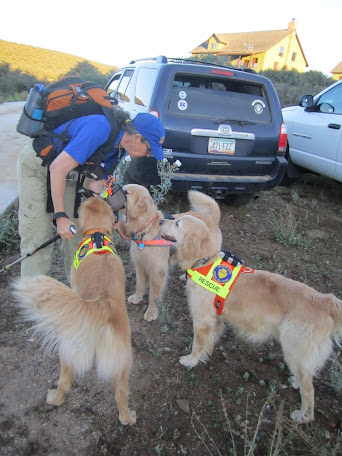Yavapai County Sheriff's deputies arrived within 10 minutes, and the search quickly expanded to include law enforcement personnel, search and rescue teams from multiple counties, and other citizen volunteers. As of dawn on Wednesday morning, Emmett still had not been found.
 |
| Searchers from multiple agencies and counties at base, getting ready to deploy |
Our SAR team from Coconino County was called to assist beginning on Wednesday. Two of my teammates and I and three golden retriever area search dogs arrived at Incident Command before 6 a.m. More of our teammates would join the search later that morning, but the three of us wanted to get started with the dogs as early as possible since they work better in the cooler air. When they get too hot, the dogs breathe more through their mouths so their noses can't work as effectively.
 |
| Cindy gets her boys ready to go |
After checking in at base, we received our assignment and went directly to our search segment. Cindy, our SAR dog handler, determined the direction of the barely detectable breeze with her little bottle of powder, positioned us accordingly for the dogs, then worked with her canine partners while also searching the thick brush herself. Her cross-trained dogs would alert her if they detected human scent, living or not.
 |
| The dogs are already working as we head to our assigned segment. |
My other partner and I flanked Cindy on either side and slightly behind her, taking care of the navigation and doing our parts in the grid search. We pushed through the tangled mass of cat claw, which grabbed at our clothing and skin, trying our best to stay in formation despite the terrain. A small child could easily crawl under the bushes and be very hard to see.
After we'd covered more than half of our assigned area, another field team of 14 searcher moved into that same segment behind us, walking a grid perpendicular to ours.
 |
| View of base from our first assigned search segment on the hill |
 | |||
| The media hang out on the periphery of the search area |
Eventually, Incident Command gave the three of us a new assignment—to work together as a K-9 team and two human man-trackers—when another field team located what looked like part of a small footprint. So we relocated to the site of that partial print and began to work the track.
We were reassigned again when another field team located fresher footprints, also small and clearly barefoot as Emmett had been reported to be and even further from the Trapps' home than we were. So, we got in our truck and took off to jump ahead of those tracks, which were headed in the direction of the highway. Our assignment was to determine if the tracks crossed beneath the highway, through the culverts. If not, we were told to work in the opposite direction of the team following the track, so we'd be going toward them. Emmett would hopefully be somewhere in the middle.
But the search came to an end just as we arrived at our new area. Sure enough, Emmett had been between us and the team on the track, who located him. Sadly, little Emmett had not survived.
